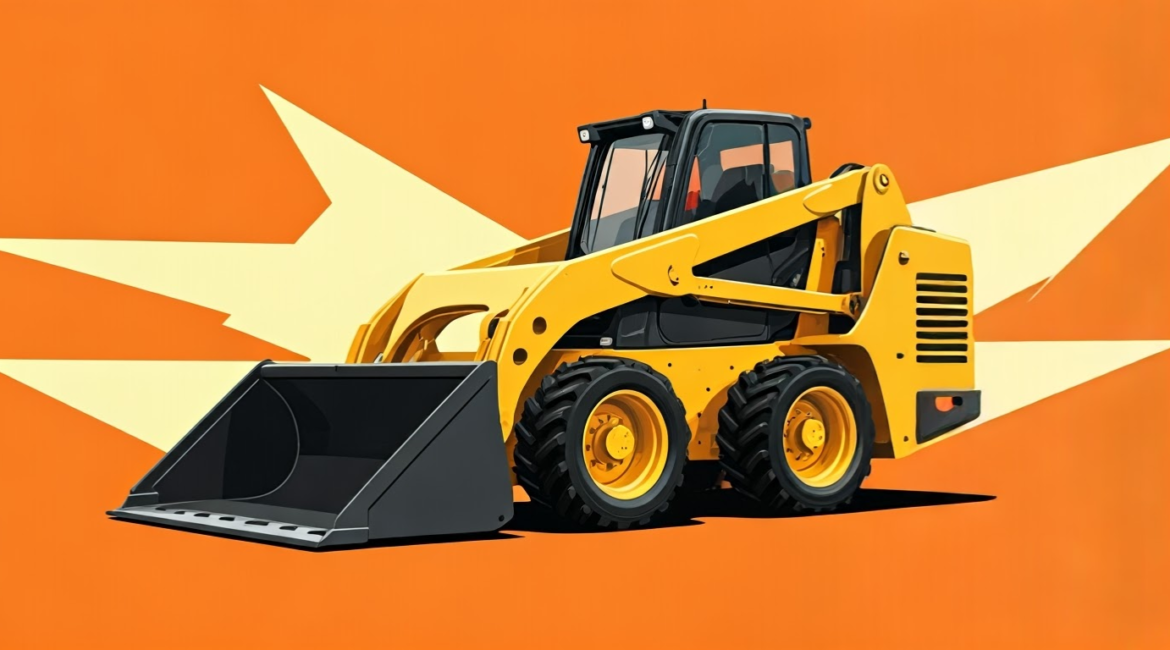The weight of a skid steer bucket plays a significant part in the overall performance and efficiency of a machine. Skid steers are multipurpose tools used in various sectors such as construction, landscaping, and agriculture.
The bucket is the main part for these machines, it enables operators as they lift, carry, and move the materials. A person’s understanding of the weight of the bucket itself is the most important along with other factors such as load capacity, machine stability, and operational efficiency.
In general, the weight of a skid steer bucket may be higher or lower, depending on its size, construction, and material mix. So, a conventional bucket can be from 300 to 800 pounds whereas specialized buckets like heavy-duty and high-capacity models, can be even heavier. The difference in weight is not just a mere number but has a direct effect on the performance of skid steers under different conditions.
A heavier bucket may be the solution for the durability and strength required for heavy tasks but at the same time, it will reduce the lifting capacity and maneuverability.
Key Takeaways
- The weight of a skid steer bucket is one of the major factors which influence the efficiency and safety of its operation.
- Characteristics like material, size, and design can make a difference to the scale of a skid steer bucket.
- The information on the weight of a skid steer bucket is the key for a safe and proper operation of the equipment.
- Safety considerations for working with a skid steer bucket cover the right kind of training, the right kind of inspection for the equipment, and the awareness of the load capacity through the implementation of proper training, equipment inspection, and load capacity awareness.
- Determining the weight of a skid steer bucket can be achieved in three ways: a scale, manufacturer specifications, or professional assistance.
The Factors Influencing the Skid Steer Bucket Weight
Commonly, the proportion of the total weight of the skid steer bucket is due to several inherent factors that are often involved in its ultimate functionality and its suitability for different applications. One of the main elements of this equation is the material type employed in producing the bucket.
Buckets made from high-strength steel usually have extra weight, but they are also able to stay in service much longer because of the superior durability they offer and the high wear and tear resistance they possess. On the contrary, lighter materials will make the construction process easier but may pose the problems of strength and durability. Another important factor is the way in which the bucket is designed.
For example, the use of a bucket manufactured with bolstered edges and with extra components such as teeth for digging will usually result in a heavier product than a traditional flat-bottom bucket. The size of the bucket will make a real difference, too, as larger ones always have a capacity to shift more material.
Thus, they will naturally be heavier than smaller ones. Besides that, as had already been mentioned, buckets that are designed for certain purposes, e.g. the ones used for grading or snow removal, will contain parts of the frame that determine the weight of such a machine.
Necessity of Getting to Know the Weight of a Skid Steer Bucket
Learning the weight of a skid steer bucket is a must for operators and managers. The most prominent one out of those is the weight management and balancing load.
Skid steers, like any other machine, have their operating capacities set, which include the weight of the machine itself and the weight of any attached implements.
Knowing the weight of the bucket means that the operator is able to calculate the additional weight they can lift still being at a safe distance from the machine’s operational ceiling. This piece of information is of utmost importance in order to avoid equipment destruction and to ensure safe operation. Furthermore, realization of the bucket weight can also have an impact on work efficiency.
To illustrate, if an operator recognizes that the bucket he is using is heavier, he will have to revise his approach both to lift and transport the materials.
This awareness can give rise to improved planning and performing of tasks, and, as a result, it can save time and lower the wear of the machine in question and, in fact, its equipment as well. Additionally, onsite knowledge of the issue can make the determination and the choice of the most suitable bucket for specific duties easier, and therefore, the operators will have the necessary tools at their disposal.
Safety Considerations for Handling a Skid Steer Bucket
ConsiderationGuidelinesOperator TrainingThe operators must be well trained to run the skid steer and handle the bucket carefully.Bucket CapacityMake sure to use a skid steer bucket which has a capacity fit to the demand at the operation.
Overloads must not be tolerated as it may lead to the tipping or an unsafe, unstable condition of the machine.Load DistributionBe sure to keep balance by distributing the load equally in the bucket.
Clear CommunicationOnce the operator and other ground personnel have signaled the handling of the bucket, they should communicate ideas clearly to each other.Machine CheckupsInspect the attachment and the bucket frequently. Check if the connection is getting worn, damaged, or is not functioning correctly.
The paramount rule for safe work is the operation of heavy machinery, such as skid steers, with attachments like buckets. Mainly, the operators should be aware of the weight of the bucket they are using. More weight than what the skid steer can handle can tip it over or make it tough to control which endangers the lives of those operating it and those around it as well.
Alongside the general statement above, operators should refer to the manufacturer’s guidelines on load ratings and stick to the provided limits at all costs. Another no less important safety factor is to carry out the attachment and detaching process correctly.
Hence, while operators want to replace their bucket or any other such attachment, they must strictly adhere to the set lifting guidelines and ensure the use of appropriate equipment to prevent any cases of accidents.
Specifically, the use of suitable personal protective equipment such as gloves and steel-toed boots and the removal of all obstacles and the people from the work area ahead of any lifting operations can be used as examples. Regular practice is required in safe operating procedures which in turn can make it unnecessary to carry out skid steer work in conditions that may lead to accidents.
How to Determine the Weight of a Skid Steer Bucket
There are different methods to figure out the Weight of a skid steer bucket, and each of them has its own level of difficulty and precision. The easiest way to find the weight of a skid steer is to refer to the specifications provided by the manufacturer or the product documentation.
Most manufacturers, particularly construction machine makers, normally give comprehensive information about their products, such as weight, dimensions, and load capacities.
This data can mostly be viewed on their websites or you can find it in their product catalogs. In the case of the persons who do not have access to this documentation or people who need to take precise measurements for certain operations, weighing the bucket directly is an alternative.
To do so, a robust weighing instrument should be employed. Workers can pick the bucket and place it onto a floor scale or use a crane scale made for heavy loads.
It’s very important to make sure that the scale used for weighing compensates for any extra attachments or modifications that can change the total weight.
Impact of Weight on Skid Steer Performance
The dimension of the bucket of the skid steer loader has a great influence on the performance of the whole machine. Bigger buckets will keep the skid steer more stable while lifting but on the other hand, they will also decrease the lifting capacity and increase fuel usage because of the added load on the engine.
Conversely, smaller buckets could be more helpful for the operator to handle the machine quickly and safely, but they may not be so durable when are heavily loaded.
On the other hand, the load factor also affects the skid-steer performance of specific tasks. For one thing, a heavier bucket can provide better grasp for digging or grading in a rough terrain thanks to the increased force applied downward.
Nevertheless, the bucket’s weight indeed results in faster wearing of hydraulic parts, if its usage is not managed correctly. On the one hand, operators have to select the bucket that suits their job soundly but on the other hand, they have to reasonably consider how its weight will affect the performance of the whole machine.
Adjusting Skid Steer Bucket Weight for Different Applications
Being the core requirement in the line-up of performance and efficiency, set points of the load of a skid steer bucket are seen as an important thing. Workers are frequently presented with such circumstances needing changes related to the respective job nature.
In this case, as for example, while on a soft ground or a rugged terrain, the use of a lightweight bucket might ensure more flexibility and reduce ground pressure, thus lowering the risk of surface damage to delicate objects.
On the other hand, a situation that is the extreme opposite to the previous one is found in the execution of demolition and excavation when a heavier bucket can be more beneficial due to its increased strength and durability.
Although the use of a lighter bucket is often the best option, there are times when the operator can add a counterweight to the bucket.
This counterbalance usually helps in situations where the load is not perfectly balanced by the use of a heavier attachment. It is essential to follow the necessary steps in terms of a complete understanding of how to adjust the bucket’s weight to the specific job requirements in order to enhance productivity and at the same time, maintaining the standards of safety.
Maintenance and Care for Skid Steer Buckets to Manage Weight
Proper maintenance and care for skid steer buckets are not only important for the extension of their life but also for controlling their effective weight during the operations.
Regular checks need to be done to see if there has been any wear and tear, damage, or corrosion that might hamper both the performance and safety of the machines.
For example, wear on the edges or cracks may occur and may be the cause of the bucket’s structural failure if the machine is loaded; the situation at hand, undoubtedly, will be very perilous. Another way to look at this is to keep the bucket free from any debris and dirt as it has to be light in order to function as expected.
Just scrape out the dirt and spoilt material since one’s load will, in an unwanted manner, increase, and therefore the effectiveness of the bucket in its required task will be adversely affected.
Lubrication of attachment points has a supplementary advantage of helping to avoid the destructive effects of hard joints used for fastening or de-fastening the bucket on and from the skid steer. Through the strict observation of these maintenance principles, operators can guarantee that their skid steer buckets will be up to the task and at the same time their operational weight will be kept under control.





